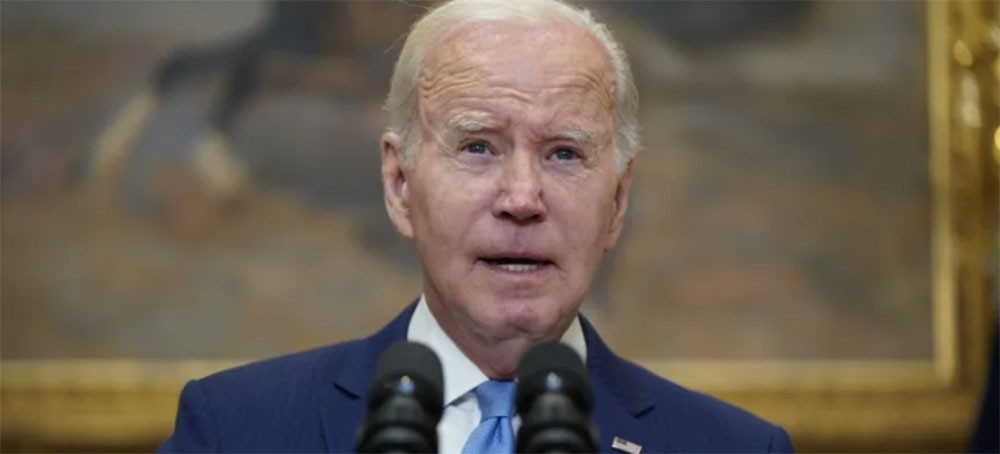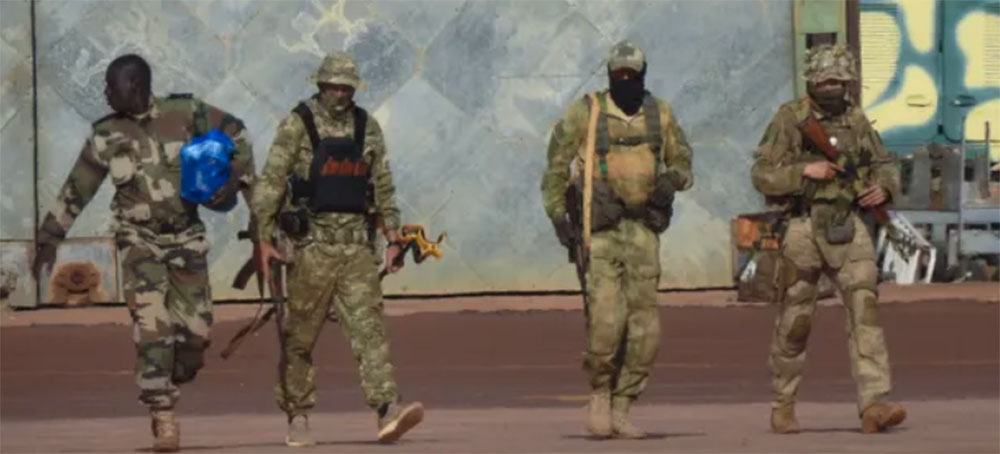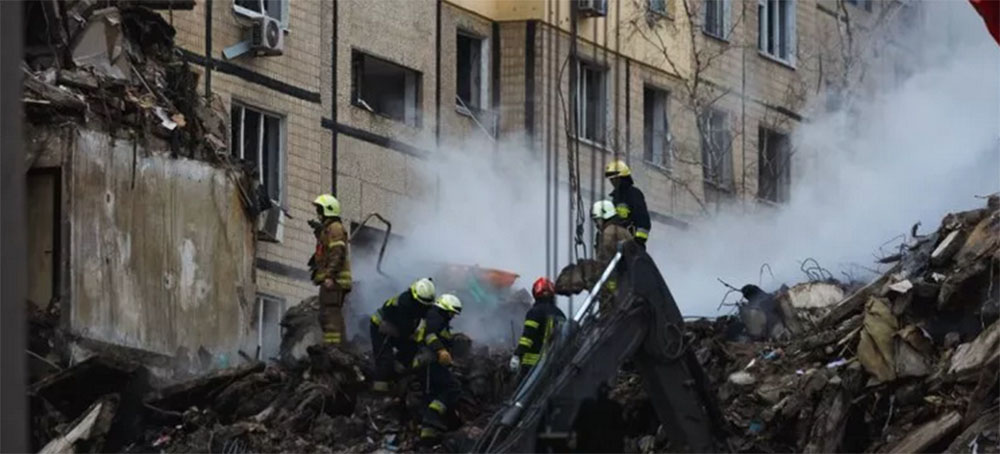Live on the homepage now!
Reader Supported News
Though the scale was unusual, this was the eighth such Russian attack on Kyiv this month alone. It is an outrage among other outrages, a terror attack among other terror attacks. In this awful war, Russia claims the right to terrorize the Ukrainian population. It attacks Kyiv and other cities not because it seeks to destroy military targets, but because it wishes to kill and injure civilians, or to destroy infrastructure so that civilians freeze and starve.
In this latest attack, Russia was trying to destroy Ukrainian air-defense systems, which save the lives of Ukrainians. They have been installed because Russia has spent the last year and more launching missiles at Kyiv and other Ukrainian cities. Attacking air-defense sites is nothing more than an attempt to keep the Ukrainian civilian population as hostages to Russian missiles. It is like murdering the lifeguard to preserve the ability to drown children.
The word "terrorism" gets overused, not least in Russia itself, where two artists were recently arrested on charges of "supporting terrorism" because of a theatrical production. This is how Russian propaganda works: we hesitate to use the word "terrorism" because the terrorists themselves use it to describe something that is not terrorism.
We have to work to preserve the concepts needed to characterize Russian behavior even as the Russian state strives to make them meaningless. It is certainly terrorism to launch missiles and drones at a city. What if, for no reason at all, the United States launched ballistic missiles at Toronto? Certainly this would be terrorism, among many other things.
And what if American leaders and propagandists, in this hypothetical scenario, gave senseless reasons for such an action? What if they claimed that Canadians and Americans were actually one people, and that Canadians who did not realize this had to be killed? That the U.S.-Canadian border was illegitimate because of Joe Biden's personal views about the past? That English speakers in Canada needed to be united with their true American homeland? That Canadian prime minister Justin Trudeau was a Nazi?
All of these senseless claims, which are (mutatis mutandis) precisely Russia's justifications for attacking Ukraine, just make matters worse. Indeed, it is at this point that the terrorism becomes fascism.
We face the same problems with the words: just as the Russian state abuses the word "terrorism" while practicing terrorism, it abuses the word "fascism" while practicing fascism. By claiming that its invasion of Ukraine was somehow against fascism, the Putin regime made it harder to point out that its own actions are fascist. Indeed, the total nonsense of the Russian invasion is fascist. It depends on a celebration of will over reason -- and an elevation of violence as the natural form of politics. That is what fascism is.
After Russian missile attacks on Ukrainian cities, Russian propagandists usually take to the television screens to celebrate. From a safe distance in Moscow, they glory in the destruction of buildings, the loss of water and electricity, the loss of life of people described as "swine," "vermin," "devils," and the like. Death is taken as the correct ending to their story of dehumanization. This amounts to daily fascist education for the Russian viewing public.
The day after these latest missile attacks, though, there was less to "celebrate," since all of the Russian missiles and drones were shot down by Ukrainian air defense. The noise woke up the city of Kyiv, but not one of the Russian missiles or drones reached its target. Kyivans have to live with the knowledge that Moscow wants them dead, but they also know that they are being defended. Of course it is good for Ukraine when its citizens are protected. But they should not be attacked in the first place.
It is also good for Russia to fail. The longer this war goes on, the longer Russians are instructed that national pride means taking pleasure in the senseless killing of civilians from a safe distance. The missiles are fired from well beyond Ukraine, from ships and airplanes that face no danger. People are just pushing buttons. The propaganda is issued in Moscow. People are just looking at cameras. Russians know, though, that Ukraine is not supposed to be able to shoot down their missiles, especially the supposedly invincible "hypersonic" kinzhal.
Frightening as it was for everyone in Kyiv, the city's successful self-defense is one small step towards the end of the war. Russian fascism depends upon a sense of impunity, on the belief that Russia is a master of violence before which the subhuman Ukrainians must cower and yield. The idea has to be rendered nonsensical, which is only possible through Ukrainian self-defense -- and Russian defeat.
READ MORE  President Joe Biden speaks about the debt limit talks in the Roosevelt Room of the White House, Wednesday, May 17, 2023, in Washington. (photo: Evan Vucci/AP)
President Joe Biden speaks about the debt limit talks in the Roosevelt Room of the White House, Wednesday, May 17, 2023, in Washington. (photo: Evan Vucci/AP)
Congressional Progressive Caucus (CPC) leaders Pramila Jayapal (D-Wash.), Ilhan Omar (D-Minn.) and Greg Casar (D-Texas) led more than 60 progressives in penning the letter to Biden on Friday, as the president attends the Group of Seven (G-7) summit abroad this week.
“If the options are either agreeing to major cuts to domestic priorities under the Republican threat of destroying the economy and moving forward to honor America’s debts, we join prominent legal scholars, economists, former budget officials, and a former president in advocating for invoking the 14th Amendment of the Constitution,” they wrote.
“Not only does the debt ceiling run counter to the Constitution’s mandate that the validity of America’s public debt shall not be questioned, it contradicts the appropriations law that requires the Treasury to issue debt for the funding you are obligated to administer at Congress’s direction,” the group added.
The letter comes as Republican negotiators indicated that bipartisan talks to resolve the nation’s debt limit fight had hit a roadblock on Friday — and blamed the White House.
Speaker Kevin McCarthy (R-Calif.) said the negotiations were on pause, claiming the other side failed to make adequate concessions on spending cuts.
“We’ve got to get movement by the White House, and we don’t have any movement yet. So, yeah, we’ve gotta pause,” McCarthy said.
“Yesterday I really felt we were at the location where I could see the path. The White House is just — look, we can’t be spending more money next year. We have to spend less than we spent the year before. It’s pretty easy.”
It also came a day after the House Freedom Caucus pushed the Senate to pass the GOP conference’s partisan debt limit package, with the group calling for “no further discussion” until it makes it out of Congress.
The statement from the hardline conservative caucus was thought to pose a threat to the GOP conference’s unity amid bipartisan debt limit negotiations between the White House and Republican leaders.
But House Freedom Caucus Chairman Scott Perry (R-Pa.) seemed to try to dial back some of the heat later on Thursday, telling CBS: “We’re not saying you can’t continue to talk, but until they’re willing to tell us what they’re willing to do, it’s hard to come to an agreement.”
Liberals and conservatives alike have been raising concerns over how far leaders on both sides will go to strike a bipartisan deal to prevent a federal default.
In their letter to Biden on Friday, progressives accused Republicans of “economic ransom,” while pressing the president against concessions that could lead to “devastating budget cuts, additional work requirements for essential food and economic support, and fast-tracking fossil fuel projects that undermine our shared climate achievements is antithetical to our shared Democratic values.”
They went on to argue that Biden should invoke the 14th Amendment, which says “the validity of the public debt of the United States … shall not be questioned,” to try to continue to issue debt to make federal payments.
But there are serious questions about the legality of such a move. And the stakes are high, as experts warn the nation’s economy could face catastrophic consequences if lawmakers fail to act quickly on the debt limit.
Meanwhile, conservatives are stepping up pressure for both sides to produce a deal that would enact new limits on annual government funding, permitting reform and changes to work requirements or federal assistance programs, among other proposals.
Less than two weeks stands between Congress and the June 1 deadline forecasted by the Treasury Department as the earliest the nation risks federal default.
READ MORE  Three Russian mercenaries and a Malian soldier on patrol in northern Mali in January 2022. (photo: AP)
Three Russian mercenaries and a Malian soldier on patrol in northern Mali in January 2022. (photo: AP)
Report implicates Wagner group fighters in Moura atrocity, including the torture and rape of civilians
Next came more helicopters, dropping troops off around the homes and cattle pens. The soldiers moved swiftly, ordering men into the centre of the village, gunning down those trying to escape. When some armed militants fired back, the shooting intensified. Soon at least 20 civilians and a dozen alleged members of an al-Qaida affiliated Islamist group, were dead.
Over the next five days, hundreds more would die in the village of Moura in the Mopti region of Mali at the hands of troops overseen by Russian mercenaries, according to a new United Nations report. All but a small fraction were unarmed civilians.
Published last week after an extensive human rights fact-finding mission conducted over several months by UN staff in Mali, the report gives an hour by hour account of events during a five-day military operation in Moura in March 2022, giving details of the worst single atrocity associated with the Kremlin-linked Wagner group outside Ukraine.
Investigators from the UN human rights office concluded that there are strong indications that more than 500 people were killed – the majority in extrajudicial killings – by Malian troops and foreign military personnel believed to be from Wagner, a mercenary outfit run by Yevgeny Prigozhin, a close ally of the Russian president, Vladimir Putin, which was linked to the massacre by internal messages obtained by the Guardian last year.
The new allegations again underline the extent of human rights abuses blamed on Wagner, which has also operated in at least six other African countries as well as Libya and Syria.
In recent months, Wagner fighters have spearheaded the Russian push to seize the Ukrainian city of Bakhmut, which has been fiercely contested by Kyiv’s forces, and suffered heavy casualties. Wagner has been accused of involvement in multiple massacres in Mali as well as elsewhere in the Sahel and central Africa. Witnesses say the group has been caught up in fierce fighting in Central African Republic in recent months.
As France and the US have shifted resources and attention away from Africa in recent years, Russia has moved to fill the gap, mounting a series of diplomatic offensives and using Wagner to win over regimes in key states by offering to bolster weak security forces against enemies ranging from Islamist extremists to pro-democracy domestic opposition parties.
Western officials allege the Kremlin is using Wagner to advance Russian economic and political interests across Africa and elsewhere. The effort is backed by an extensive disinformation campaign, they say.
Analysts have recorded a surge in violence wherever Wagner has deployed, although rarely with much military success for governments. Last month, at least nine civilians were killed and more than 60 injured in a triple suicide bomb attack in the central Mali town of Sévaré early on a Saturday, an official has said.
When the Russian mercenaries were hired in Mozambique in 2019 to fight Islamist militants there, they were forced to withdraw after suffering heavy casualties. Eventually, Rwandan regular troops were flown in, successfully countering the insurgents’ offensive.
Few of the atrocities alleged to have involved Wagner have been conclusively linked to the group, however. A lack of witnesses, resistance from local regimes, poor infrastructure and acute insecurity have made full investigation of claims difficult.
The Moura massacre is an exception, however. “These are extremely disturbing findings,” said Volker Türk, the UN high commissioner for human rights. “Summary executions, rape and torture during armed conflict amount to war crimes and could, depending on the circumstances, amount to crimes against humanity.”
Malian authorities denied requests by the team to access Moura itself but the report is based on interviews with victims and witnesses, as well as forensic and other information sources, such as satellite imagery.
Mali’s elected president, Ibrahim Boubacar Keïta, was toppled in August 2020 by officers angered at the failures to roll back the jihadist insurgency. In 2021, the military forced out an interim civilian government and tilted dramatically towards Moscow, concluding an agreement in which about 1,000 fighters from the Wagner group were deployed to bases across much of the country, which also received consignments of Russian weapons.
A Malian government spokesperson described the report as “biased” and “based on a fictional account”, and said an investigation by Malian judicial authorities had found “not a single civilian in Moura was killed during the military operation”, only “armed terrorists”.
The operation – described by the authorities as an anti-terrorist military operation against an Islamist extremist group, Katiba Macina, which has imposed its rigorous and intolerant version of sharia law on inhabitants, raised taxes and made local men follow their dress codes – began on 27 March 2022, a busy market day in Moura.
The accounts gathered by the UN support the testimony of witnesses who spoke to reporters last year. Amadou Barry, who lives in the neighbouring village, told the Observer he was attending the market in Moura when helicopters suddenly appeared and troops disembarked, prompting a small group of Islamist militants in the village to shoot at the soldiers before fleeing on motorbikes.
“We started running in every direction, some into the houses. The Malian army then opened fire on people running, killing so many people,” he said.
Then, over the next four days, at least 500 people are believed to have been killed, says the report, which names at least 238 of these victims.
Héni Nsaibia, senior researcher at ACLED (Armed Conflict Location and Event Data Project), said in the weeks after the massacre that between 60 and 100 of those killed may have been unarmed Islamist militants, but the rest were civilians. Government forces found large quantities of weapons in Moura.
Witnesses reported seeing “armed white men” who spoke an unknown language operating alongside the Malian forces and at times appearing to supervise operations, the report found. It cites witnesses who claimed Malian troops were rotated in and out of Moura daily, but the foreign personnel remained.
Internal Malian army documents obtained by the Guardian last year revealed the presence of Wagner fighters – referred to as “Russian instructors” – on “mixed missions” with Malian soldiers and gendarmes around the time of the Moura massacre. Wagner were deployed near Moura at the time, and took part in other operations in which many civilians were killed.
According to the new report, on the day after the initial assault soldiers began going house to house searching for “presumed terrorists”, selecting and killing people with long beards, people wearing ankle-length trousers (a sign of religious devotion), people with marks on their shoulders – seen as evidence of firing or carrying weapons – and even those who merely showed signs of fear.
A group of men rounded up in the south-east of the village were led away by soldiers and shot in the head, back or chest, and their bodies thrown into a ditch. Witnesses said that those who resisted or tried to flee were also executed by the Malian armed forces and the “armed white men” and dumped into the ditch.
Detainees were subjected to torture and other ill-treatment during questioning, and dozens of women and girls were raped or subjected to other forms of sexual violence, the report claims. In one instance, soldiers brought bedding from a house, placed it under trees in the garden, and took turns raping women they had forced there.
Samira Daoud, Amnesty International’s regional director for west and central Africa, said what happened in Moura could constitute crimes under international law.
“While the [UN] notes that around 30 combatants from the armed group Katiba Macina were present in Moura on 27 March 2022 … their presence can in no way justify the extrajudicial executions, rapes and looting committed by the armed forces against the inhabitants and stallholders trapped by their siege,” Daoud said.
Analysts have expressed concerns that the recent crisis in Sudan has distracted attention from deepening problems across the Sahel, an unstable belt of desert and grazing running east from Senegal across the African continent. The zone is afflicted by extreme weather linked to climate change, displacement of millions of people, acute political instability and growing violence. Analysts fear the conflict in Sudan may lead to a “domino” effect of state collapse.
READ MORE Leonardo DiCaprio and Lily Gladstone in 'Killers of the Flower Moon.' (photo: Apple TV+)
Leonardo DiCaprio and Lily Gladstone in 'Killers of the Flower Moon.' (photo: Apple TV+)
The filmmaker takes on David Grann’s bestseller about a murder epidemic among the Osage and turns it into a masterpiece
An adaptation of David Grann’s 2017 true-crime bestseller, Killers of the Flower Moon would be a big deal regardless of who was making it. That this is the latest from Martin Scorsese, starring both Leonardo DiCaprio and Robert De Niro — acting together for the first time in one of the director’s movies — and the closest thing he’s made to a genuine Western, has caused it to be viewed less as a film than as a potential earthshaking event. A single still of DiCaprio and Lily Gladstone sitting at a table, her staring sideways at him as he blankly stares heavenward, was the only hint we had for months regarding what was in store; film nerds studied it like the Zapruder footage for clues. Anticipation mounted. Questions were abundant: Would it focus more on the community’s response to the killings, or the F.B.I.’s investigation? Was this going to be Scorsese’s corrective to a genre that’s done wrong to Native people for over a century? Or would it turn out to be another well-intentioned white savior story? What’s the deal with DiCaprio’s jaw?!
We now have answers, and can confirm that the end result was indeed worth the wait. Structured as the sort of throwback, big-picture epic that characterized ambitious moviemaking in the 1970s and early ’80s, Killers of the Flower Moon is, at its core, a love story. But it’’s also a mystery, albeit not one with simplistic whodunnit solutions; a highly gothic take on the white-hat horse operas of yesteryear; a star vehicle, featuring a career-best performance from an actor whose talent too often gets eclipsed by his celebrity; a continuation of a sui generis 50-year collaboration between two artists/coupla guys from Little Italy; and an indictment of white supremacy, then and now. Above all, it’s a Martin Scorsese picture, brimming with reverence for a culture that survived a horrible trauma as it is filled with exhilarating flourishes, film history references, and explorations of the faultline between the sacred and profane. And yes: It’s a masterpiece.
The word’s overused, sure. But what else can you call a work that finds the 80-year-old director — considered by many to be our greatest living American filmmaker and caretaker of the seventh art’s flame — turning a sprawling, three-and-a-half-hour drama involving power, corruption and our nation’s toxic past into an intimate story, without sacrificing its depth or scope? Opening on a surreal dance under a shower of “black gold” and old-timey silent newsreels of Oklahoma’s Osage aristocracy, the movie immediately establishes a final bastion of wild-frontier life mixing with financial prominence in the early ’20s. A stranger, new to this world of wealth and old, weird American types trying to grift it, pulls into town: This is Ernest Burkhart (DiCaprio), fresh off the frontlines of World War I. The young man in the doughboy uniform is, to blunt, not very bright. He does like whisky, women and money, however, and not in that order. And that makes him an attractive prospect for manipulation to one man in particular.
Burkhart has come to the Sooner State to work for his uncle, William Hale (De Niro), the cattle baron who considers himself the best friend the Osage have ever had. “‘Call me ‘King,’” the older man tells his nephew, and sits him down inside his den to explain how things work round these parts. A person shouldn’t drink too much, lest he indulge in “blackbird talk.” Be careful around the criminal elements who treat the surrounding areas as a way station between illegal activities. If he’s going to get into trouble, make it “big trouble.” He should consider Hale more of a father figure than an uncle. (Let’s pause for a moment to praise Jack Fisk, the legendary art director and production designer of Badlands, There Will Be Blood and too many other landmark movies to count; he and his team turn Hale’s ranch into a warped Xanadu that’s part mausoleum, part masculine predator’s lair. It’s one of many extraordinary, character-informing touches in a film filled with them.)
Most of all, Hale says, Ernest should get to know as much about the Osage as he can. “They are the most beautiful people in the world,” he says, before the movie abruptly cuts to a Native American having a violent seizure on a wooden apartment floor. A series of deaths, all of them involving healthy Osage locals who suddenly fall ill or fall victim to outright murder — and most of them accompanied by a voice saying “No investigation” — play out. Then we meet the woman narrating this homicide montage: Mollie Kyle (Gladstone). Her family owns one of the tribal land headrights that’s kept the money coming in to town. Ernest ends up becoming her driver, partially out of circumstance, and then her sweetheart, initially because his uncle thinks getting in good with the Kyles would benefit him.
Mollie has a sunbeam of a smile, which sometimes translates as the look of pity you’d give a slow child when Ernest says something ridiculous. She recognizes what this white man is after — “Coyote wants money” — but he’s handsome, and kind, and is honest about liking the good life and liking her. They fall in love and marry. Meanwhile, one of her sisters, Minnie (Jillion Dion), has been inexplicably sick. Her mother, Lizzie (Tantoo Cardinal), too, has seemed infirm as of late. Then her sister Anna (Cara Jade Meyers), the wild child of the family, goes out gallivanting one night and doesn’t come home. They eventually find her body near a creek. “This blanket has become a target on our back,” Mollie says. As for Hale, he keeps insinuating that Ernest get what’s rightfully his. And soon enough, this “Reign of Terror” that everyone in town is talking about soon begins to hit Mollie herself, much closer to home….
It’s Ernest’s two central relationships — between a husband and his wife, and between a malleable man and the surrogate father who becomes a devil on his shoulder — that define not just Killers of the Flower Moon’s dynamic, but distinguish the movie from its source material. David Grann’s book ran parallel narratives, following both the timeline of these serial killings and the concurrent formation of a government-sanctioned “Bureau of Investigation” by J. Edgar Hoover; the Osage murders were one of the first major cases they took on, with a former Texas Ranger named Tom White chasing down leads. It was a detective story mixed with deep reportage on systematic racism that had been treated as a historical footnote. “When I began the story I was thinking, ‘It’s a whodunnit kind of thing, right?’” Grann noted upon the book’s publication. “And by the end, [it] was like, ‘Who didn’t do it?’”
Scorsese and his fellow screenwriter, Oscar winner Eric Roth (Forrest Gump, The Insider, Dune) take a different tact. Tom White, played with an impressive sense of quiet authority by Jesse Plemons, doesn’t show up until the last quarter of the movie. Instead, we spend a lot of time with Ernest and Mollie, and the tension that builds when it looks as if he’s slowly removing the one person standing between him and his wife’s wealth. It’s a stand-in for the larger betrayal that’s happening to the community, complicated by the fact that DiCaprio plays Ernest as someone devoted to his wife. The actor has always excelled in his work with Scorsese because he understands how to play duality, a recurring theme in the filmmaker’s back catalog overall (see: Catholicism). Here, DiCaprio is forced to psychologically crack open a murderer under the sway of a Svengali and in love with his victim. Not even a set of false teeth and a Southern-fried, slow-witted accent can derail how brilliantly he plays the conflict, the denial, the guilt that comes with double-crossing your soulmate. (DiCaprio and De Niro’s scenes together, it should be said, give you the impression of watching two pro boxers trading punches, and you bemoan the fact that it’s taken them this long to follow up on their This Boy’s Life rapport.)
That’s what Scorsese is interested in — a love story tainted by greed, collusion, and a society built on prejudice-scorched earth rather than a procedural — and that’s what DiCaprio and Gladstone give us. She’s the undisputed MVP of Killers, which is no easy feat when you’re up against two best-of-their-generation contenders. It’s hard to think of another working actor who knows how to use just the movement of their eyes to such good effect; a scene in which she sizes up DiCaprio before inviting him to silently contemplate a rainstorm next to her makes you think you’re seeing Dietrich one second, De Havilland the next. It helps that cinematographer Rodrigo Prieto, another longtime Scorsese collaborator, knows exactly how to light her, but Gladstone is the one making the heavy lifting seem graceful. She turns Mollie into someone who doesn’t trust easily; who gives a man she knows to be good at heart her trust; and then watches it all turn to ash as he keeps giving her “medicine.” She gives this epic a broken-hearted pulse and its backbone.
Their doomed romance is also the throughline that guides Killers of the Flower Moon though a number of expository patches, cultural anthropology, bonus genre detours (black comedy, courtroom thriller, Freudian family drama), and a lot of covered historical and sociological ground. Scorsese is after big game here, and like The Irishman, this range noir writ large justifies its length. What sticks with you, though, is not the film’s hugeness but its humanity. It ends not on a moment of mournfulness and opts, instead, for a closing image that suggests survival, endurance, a ritual of affirmation. No one makes movies like this anymore, that go for broke yet keeps its eyes on the universal experiences of love, death, healing, and forgiveness. Maybe no one else can. But we’ve got a truly masterful example of how to do it, from an artist who hasn’t given up on the power of the moving pictures as mass-appeal empathy machines. Cinema’s not dead yet.
READ MORE  Tennessee Gov. Bill Lee. (photo: Rogelio V. Solis/AP)
Tennessee Gov. Bill Lee. (photo: Rogelio V. Solis/AP)
Republican leaders in Tennessee, Mississippi, and Texas are targeting Democratic communities and institutions
All of the proposed legislation targets issues that are particularly sensitive for marginalized areas, like elections and criminal justice. In Mississippi and Texas in particular, the legislation is targeted specifically at localities where people of color are the majority. Efforts in all three states indicate an alarming trend, in which Republican leadership is attempting new strategies to further erode democracy, particularly in majority-minority areas and Democratic strongholds.
Some of these efforts, like the state government’s push to control policing and the court system in Jackson, Mississippi’s majority-Black and underserved capitol, have been in the works for months. Tennessee will eliminate community boards that oversee local police forces as of July 1.
In Texas, a bill which has already passed the state Senate would remove Harris County’s elections administrator and hand those duties over to the tax assessor-collector and the county clerk, the Texas Tribune reported earlier this month. Another would allow the secretary of state to call a new election in the case that ballots aren’t available, according to the Washington Post. Yet another bill would allow the secretary of state to appoint a marshal to investigate voting complaints.
“I think it would make a mockery of our democracy,” Harris County Commissioner Rodney Ellis, a Democrat, told the Post. “It would be a throwback to the forties and fifties.”
Republican Senator Paul Bettencourt said his initial bill was written to include counties with populations larger than 1 million, but that a study by his office found that Harris County was the only such municipality that repeatedly had election issues, according to the Tribune. Harris County did not create an elections department and appoint an elections administrator to run its elections till 2020, and voters did experience problems in that year’s election, including malfunctioning voting machines, a shortage of paper ballots, and long waits at polling stations.
But Bettencourt’s legislation seems to be motivated by election fraud conspiracies, rather than providing the funding, resources, and training that would help Harris County elections run efficiently and without significant problems.
In all of these cases, rather than invest in public services necessary for the functioning of communities and local democracy, Republican leadership’s apparent answer is to underfund institutions or, as the past several months have shown eliminate or curtail local control.
Texas, Mississippi, and Tennessee: Three makes a trend
Mississippi’s Republican governor and Republican-dominated state legislature have been attempting to expand the presence of the capitol police force, as well as establish an alternative to the Hinds County Circuit Court, where elected judges would be replaced with state-appointed ones — at least for part of the city.
Jackson is a majority-Black city with a progressive, Black mayor. Chokwe Antar Lumumba came into office in 2017 with 93 percent of the vote. Lumumba referred to himself as a “revolutionary,” much like his father, Jackson’s former mayor Chokwe Lumumba Sr. The younger Lumumba had a vision for Jackson, whose Black population has long suffered from the architecture of white supremacy in the South; after decades of racist vigilante violence, Jim Crow legislation, and backlash against the civil rights movement, Lumumba hoped to build a prosperous Jackson that would strive “not only to correct the ills as we see them, but to be a model for the nation of what progressive leadership and collective genius can accomplish,” as he told the Guardian in a post-election interview.
The state of Mississippi has been working against that vision in recent months, by introducing a slate of bills that wrest control of Jackson’s water system, police force, court system, and sales tax allocations from the local elected government to the Republican, white leadership in the state, all of which seems to benefit Jackson’s white population far more than its Black residents, who make up about 80 percent of the population.
Jackson certainly has problems — the water system is so degraded that residents cannot drink tap water or brush their teeth with it unless it’s boiled first. Garbage collection is another recent critical issue, as are high rates of crime and poverty.
Rep. Trey Lamar, a Republican from northwest Mississippi who sponsored the bill to take over Jackson’s police force and court system, denied that the legislation was racially motivated during an interview with the New York Times; his measure, he said, was instead focused on helping the city solve its problems with crime and court backlogs.
But it’s hard to ignore the message that, “This is a thing of, ‘Black folks can’t govern. Black leaders can’t govern,’” as Danyelle Holmes, an organizer with the Mississippi Poor People’s Campaign, told NPR in March.
In Tennessee, Republican Gov. Bill Lee signed a bill on Thursday which will eliminate civilian oversight boards for local police forces. They don’t exist in every city in Tennessee, but there is a Civilian Law Enforcement Review Board in Memphis, the city where Tyre Nichols was beaten to death by police officers in January. In Memphis, the CLERB “has the power to receive, investigate, hear cases, make findings, and recommend action on complaints regarding excessive and deadly force,” according to the Memphis city government website.
“Any community that’s dealing with a significant incident of police abuse — obviously the situation with Tyre Nichols was a particularly egregious and high-profile situation — but I think probably one of the most common problems that we hear of is that there’s not enough transparency, there’s not enough community access to what the city’s doing about the problem,” Lauren Bonds, executive director of the National Police Accountability Project, told Vox. Community and civilian oversight boards like the kinds Tennessee will eliminate help communities access information about their police force and provide a mechanism for accountability when the police force is accused of wrongdoing.
Tennessee’s new legislation will replace the community oversight boards with police advisory and review committees on July 1. These committees will have no power to investigate police forces, and only members appointed by the mayor will be allowed to bring complaints to the police force’s internal affairs unit. There will be no mechanism for independent investigations of police misconduct, as the Associated Press reported Thursday.
Republicans have come up with more creative ways to try and eliminate Democratic control
Republican efforts to limit Democratic power and representation are nothing new. Gerrymandering, for example, has been a scourge on the electoral system, with Republicans and Democrats both redrawing maps to try and rig electoral districts in their favor.
State legislatures, too, have worked to limit the influence of Democrats in power, most notably in the case of North Carolina’s Democratic Gov. Roy Cooper. As Vox reported in April:
House Bill 17, which [former Gov. Pat] McCrory signed into law in December 2016, hamstrung Cooper’s ability to appoint staff, required cabinet appointments to be approved by the legislature, and limited Cooper’s control over the education system. Senate Bill 4 turned the state’s Supreme Court elections into a partisan process, requiring candidates to disclose their party affiliation on a ballot. The bill also changed requirements for appeals, routing all cases through the Republican-controlled appeals court, and limited Cooper’s control over the state and county boards of elections; McCrory, a Republican, signed both bills into law.
The legislative efforts in states like Texas, Tennessee, and Mississippi are specific and subtle, and are ostensibly proposed to correct real problems. But they also fit into a larger framework of Republicans attempting to wrest solidify control in whatever way they can in states where they hold legislative and executive power.
READ MORE Members of the far-right Proud Boys in front of the US Capitol on January 6, 2021. (photo: Jim Urquhart/Reuters)
Members of the far-right Proud Boys in front of the US Capitol on January 6, 2021. (photo: Jim Urquhart/Reuters)
The leader of a Washington, DC police intelligence unit faces allegations he tipped off the leader of the far-right group.
Lieutenant Shane Lamond of the Metropolitan Police Department in Washington, DC, is accused of giving Proud Boys leader Enrique Tarrio confidential information, the US Justice Department said.
The information pertained to an investigation into the 2020 burning of a “Black Lives Matter” banner stolen from a church in the US capital. Lamond is also accused of tipping Tarrio off that he faced arrest in the matter.
Lamond, who supervised the Intelligence Branch of the police department’s Homeland Security Bureau, also made false and misleading statements to federal law enforcement agents about his communications with Tarrio, the Justice Department said.
A federal grand jury indicted Lamond on one count of obstruction of justice and three counts of making false statements. He was arrested on Friday and faces a maximum of 30 years in prison.
The police department said Lamond, who has worked for the force for 24 years, was placed on administrative leave in February 2022 because of the Justice Department’s investigation.
A lawyer for Lamond did not immediately respond to a request for comment.
According to the indictment, Lamond and Tarrio had been in regular contact since 2019. Prosecutors disclosed communications between the two including a text exchange after the 2020 presidential election, in which Democrat Joe Biden defeated then-President Donald Trump.
Lamond wrote: “Hey brother, sad, sad news today. You all planning anything.”
“Yep,” Tarrio responded.
Tarrio pleaded guilty to charges in the Black Lives Matter banner case and was sentenced to five months in prison in 2021.
A jury in a separate case this month convicted Tarrio and other members of the Proud Boys of seditious conspiracy involving the attack against the US Capitol on January 6, 2021, by Trump supporters.
READ MORE  Water levels at Lake Powell, the nation's second-largest reservoir, remain critically low because of a climate-change-driven megadrought and overuse of the Colorado River's water. (photo: Claire Harbage/NPR)
Water levels at Lake Powell, the nation's second-largest reservoir, remain critically low because of a climate-change-driven megadrought and overuse of the Colorado River's water. (photo: Claire Harbage/NPR)
Combined, researchers found, the global decline in water storage equivalent to 17 Lake Meads — the largest reservoir in the U.S.
People overusing water for agriculture and development, and human-caused climate change are the primary drivers of the decline, particularly in natural lakes, said Fangfang Yao, the study's lead author. In reservoirs, dirt and sand piled up behind dams also played a major role in declining water levels.
The findings were staggering, the authors said.
"Roughly one-quarter of the world's population lives in a basin with a drying lake," Yao said. "So the potential impact could be significant."
The study looked at nearly 2,000 of the planet's largest lakes and reservoirs using three decades of satellite observations and climate models to measure how bodies of water have shrunk or grown over time, and to parse out what influenced the change. For example, did a lake shrink because of increased evaporation with hotter temperatures, or because it was diverted for agriculture?
The findings revealed "significant declines," the research paper said, across 53% of the lakes and reservoirs surveyed by the team from the University of Colorado Boulder's Cooperative Institute for Research in Environmental Sciences.
At least half of the decline in natural lakes was driven by human-caused climate change and overconsumption. That's a finding, Yao said, that should help water managers better manage and protect threatened lakes around the world.
"If you know a lake is falling and that loss was attributable to human activities, can we put more of an emphasis on conservation and improving water efficiency?" Yao said.
A climate change-driven megadrought and an ever-growing human thirst have continued to drain the two largest reservoirs in the U.S. — Lake Powell and Lake Mead, which the Colorado River feeds. Lake Chad, one of Africa's largest freshwater lakes which supplies nearly 40 million people with water, has shrunk by an estimated 90% since the 1960s.
The United Nations regards access to safe drinking water as a universal human right. But its own figures show roughly 2 billion people around the world do not have access to it and roughly half the world's population experiences severe water scarcity at least once a year.
"Uncertainties are increasing," said Richard Connor, the editor-in-chief of a U.N. water report published earlier this year at a press conference in late March, where world leaders met to try and find better strategies for managing the planet's rare freshwater. "If we don't address it, there will definitely be a global crisis."
Follow us on facebook and twitter!
PO Box 2043 / Citrus Heights, CA 95611



No comments:
Post a Comment
Note: Only a member of this blog may post a comment.